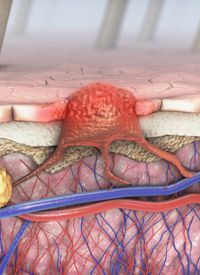RP1/Nivolumab Earns Priority Review in Anti–PD-1 Failed Advanced Melanoma
RP1 with nivolumab elicited an ORR of 38.7% with an acceptable safety profile in patients with advanced melanoma who progressed on anti–PD-1 therapy.
RP1 with nivolumab elicited an ORR of 38.7% with an acceptable safety profile in patients with advanced melanoma who progressed on anti–PD-1 therapy.

The FDA has accepted and granted priority review to a biologics license application (BLA) for vusolimogene oderparepvec (RP1) in combination with nivolumab (Opdivo) for the treatment of patients with advanced melanoma who progressed on an anti–PD-1 therapy, according to a press release from the developer, Replimune.1
A Prescription Drug User Fee Act date of July 22, 2025, has been set. In November 2024, the BLA was submitted, and the drug was also granted the breakthrough therapy designation in this patient population.2
Supporting data comes from the primary analysis of the open-label, dose escalation and expansion phase 1/2 IGNYTE trial (NCT03767348) evaluating the safety and preliminary efficacy of RP1 alone and with nivolumab in patients with advanced and/or refractory solid tumors.
“There are limited treatment options and a significant unmet need for patients with advanced melanoma who previously received an anti–PD-1 containing regimen,” Sushil Patel, PhD, chief executive officer of Replimune, said in the press release.1 “The BLA acceptance is an important milestone for Replimune, and we look forward to working closely with the FDA on the review of our application.”
Findings from the IGNYTE trial were presented at the 2024 European Society for Medical Oncology (ESMO) Congress.3
Assessed per modified RECIST v1.1 criteria, at 12 or more months of follow up, the overall response rate (ORR) among patients who received single-agent anti–PD-1 therapy (n = 75) was 38.7%; complete responses (CRs) were observed in 21.3%, partial responses (PRs) in 17.3%, stable disease (SD) in 26.7%, and progressive disease (PD) in 32.0%. Among patients who received anti–PD-1 adjuvant therapy (n = 36), the ORR was 44.4%; CRs were observed in 30.6%, PRs in 13.9%, SD in 27.8%, and PD in 25.0%. Among patients who received non-adjuvant anti–PD-1 therapy (n = 104), the ORR was 29.8%; CRs were observed in 9.6%, PRs in 20.2%, SD in 29.8%, and PD in 32.7%.
In patients who had primary resistance to anti–PD-1 therapy, the ORR was 35.9%; CRs were observed in 17.4%, PRs in 18.5%, SD in 23.9%, and PD in 33.7%.
The median duration of response (DOR) from treatment initiation was 27.6 months (range, 6.6+ to 45.3+), and the median DOR from treatment response was 21.6 months (range, 1.2+ to 43.5+). Additionally, at 1 or more years from starting treatment, 85% of responses were ongoing.
Among all patients, 1-, 2-, and 3-year overall survival (OS) rates were 75.3%, 63.3%, and 54.8%, respectively; median OS was not reached at the time of analysis.
Regarding safety, at least 1 treatment-related adverse event (TRAE) of any grade and grade 3/4 occurred in 89.4% and 12.8% of patients, respectively. The most common TRAEs of any grade were fatigue (32.6%), chills (31.9%), pyrexia (30.5%), nausea (22.0%), and influenza-like illness (17.7%). TRAEs of grade 3 or higher included fatigue (0.7%), diarrhea (0.7%), asthenia (0.7%), arthralgia (0.7%), and decreased appetite (0.7%).
The primary end points of the IGNYTE trial were safety and efficacy using modified RECIST v1.1 criteria assessed by independent central review. Secondary end points included ORR by investigator assessment, DOR, CR rate, disease control rate, and 1-year and 2-year OS.
A total of 140 patients with advanced melanoma who had progression on prior anti–PD-1 therapy, measurable disease, adequate organ function, an ECOG performance status of 0 or 1, and no prior oncolytic therapy were enrolled in the trial.
During the first 2-week cycle, patients received 1x106 pfu/mL of RP1; during cycles 2 to 8, patients received 1x107 pfu/mL of RP1 and 240 mg of nivolumab; during cycle 9, patients received 240 mg of nivolumab; and from cycles 10 to 30, patients received 480 mg of nivolumab once every 4 weeks.
A confirmatory analysis is being performed in the phase 3 IGNYTE-3 trial (NCT06264180) evaluating RP1 with nivolumab compared with physician’s choice of treatment in patients with advanced melanoma who had disease progression on anti–PD-1 and anti–CTLA-4 therapies.
References
- Replimune announces biologics license application acceptance and priority review for RP1 for the treatment of advanced melanoma. News release. Replimune. January 21, 2025. Accessed January 21, 2025. https://tinyurl.com/94jc39by
- Replimune receives breakthrough therapy designation for RP1 and submits RP1 biologics license application to the FDA under the accelerated approval pathway. News Release. Replimune. November 21, 2024. Accessed January 21, 2025. https://tinyurl.com/2p8ym2tj
- Robert C, Milhem MM, Sacco JJ, et al. LBA46 Primary efficacy, safety, and survival data from the registration-intended cohort of patients with anti–PD-1–failed melanoma from the IGNYTE clinical trial with RP1 combined with nivolumab. Ann Oncol. 2024;35(suppl 2):S1236-S1237. doi:10.1016/j.annonc.2024.08.2287
Newsletter
Stay up to date on recent advances in the multidisciplinary approach to cancer.